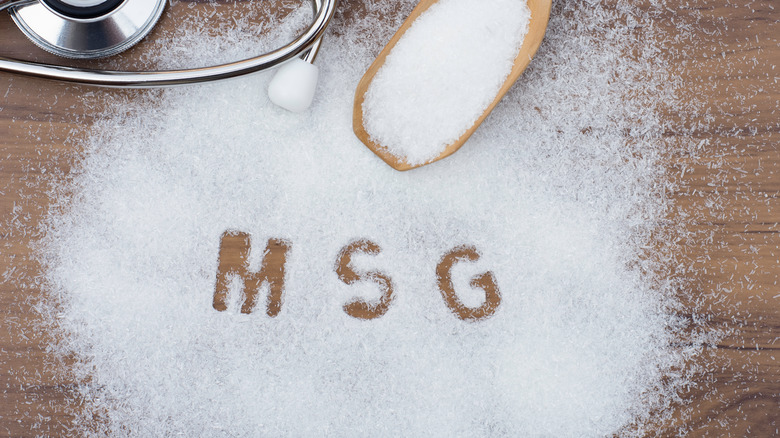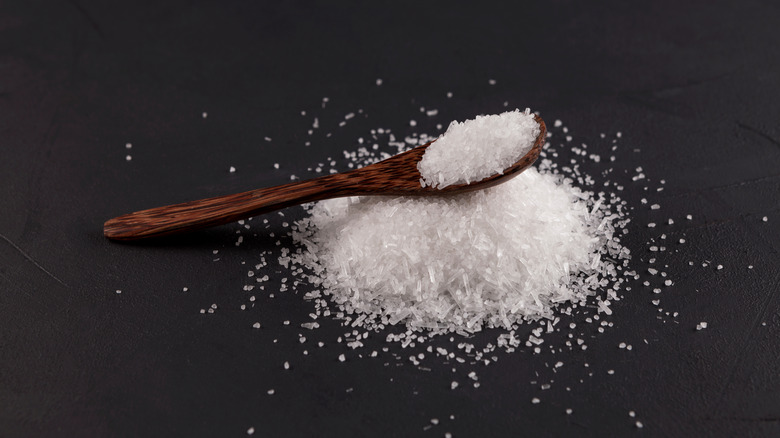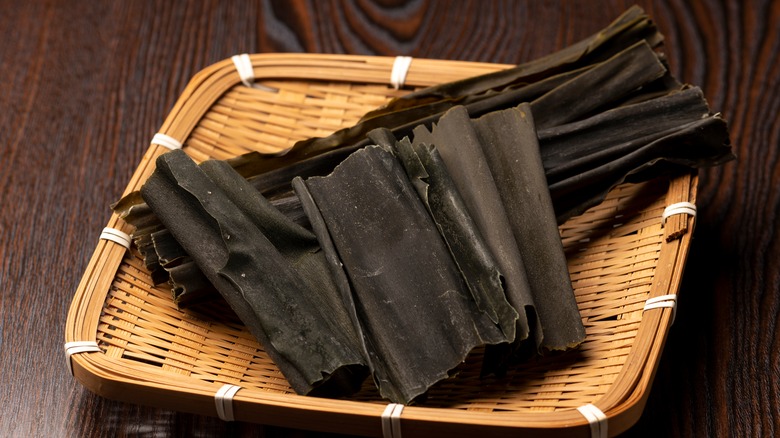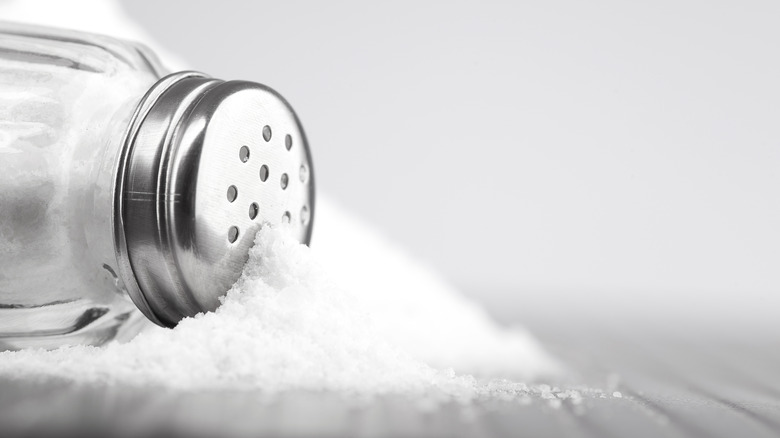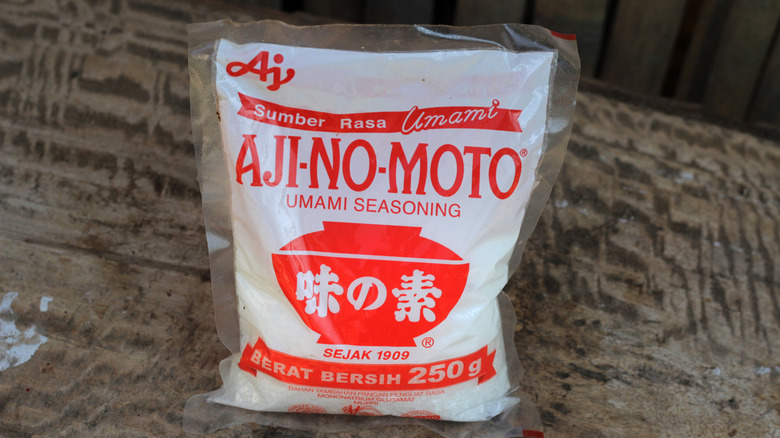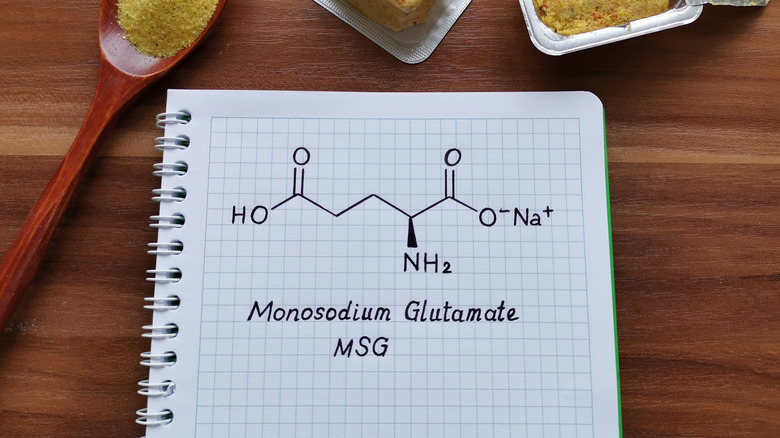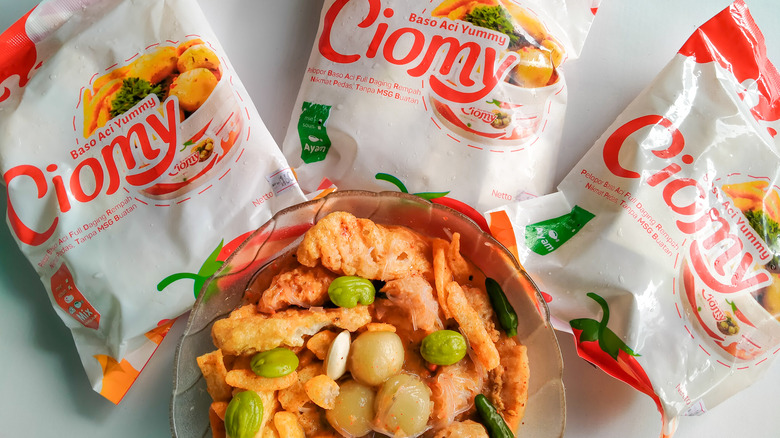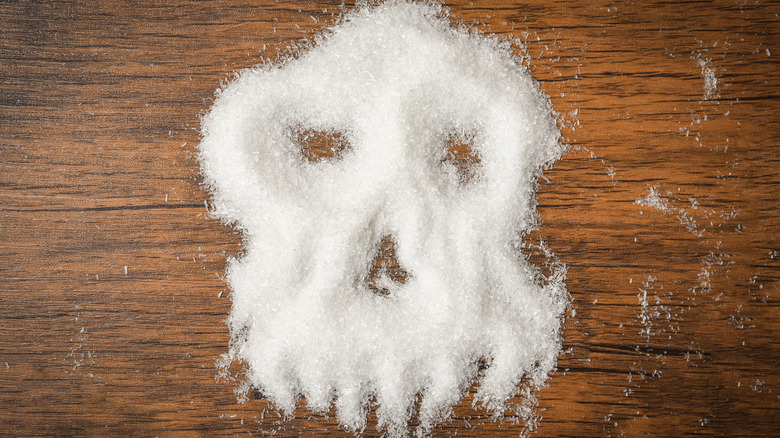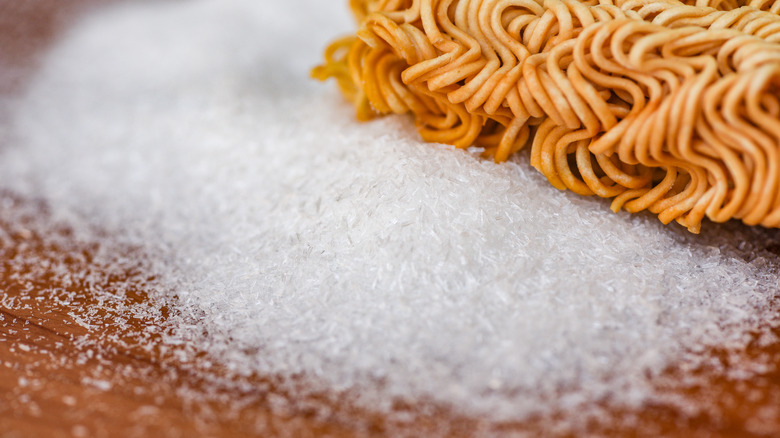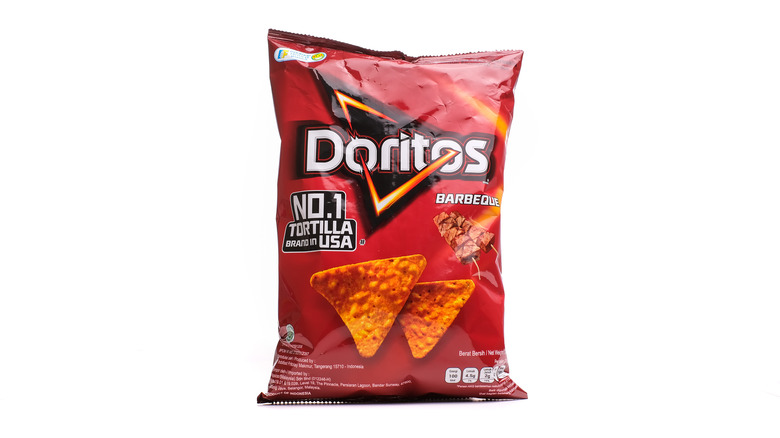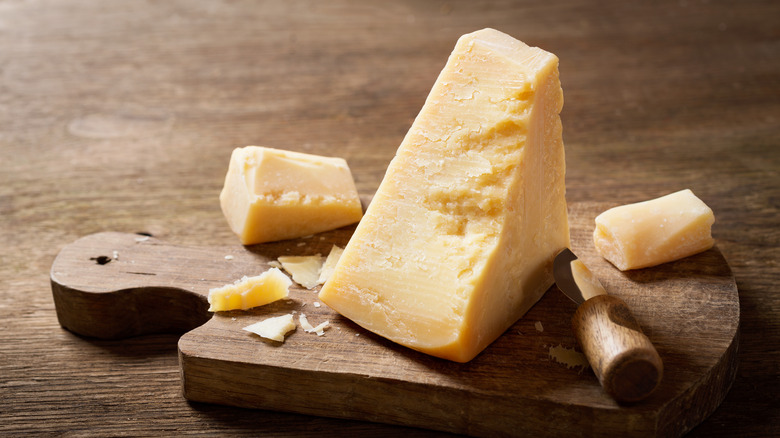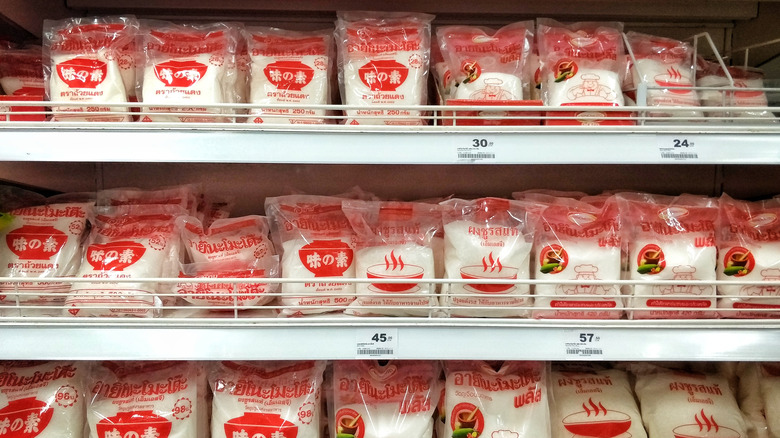What Exactly Is MSG And Is It Bad For You?
MSG (monosodium glutamate) is one of the most misunderstood ingredients in America. Perhaps part of the reason people are so afraid of it is its name; many tend to shy away from ingredients with names that sound too chemical-y these days. Of course, anything can be made to sound scary if you refer to it by its scientific name. Sodium chloride and dihydrogen monoxide both sound like they could kill you, but they're just salt and water. Perhaps MSG would be viewed in a different light in the U.S. if it was called "essence of taste," as the name popular Japanese brand Ajinomoto translates to, or "tasting powder," as it is known elsewhere (via IndiaMART).
But what even is MSG? This common food additive is ubiquitous in packaged foods and in the cuisines of many cultures, particularly in Asia, but is relatively uncommon in home kitchens in North America. We'll delve into what MSG adds to food, how it's made, how common sensitivity to the ingredient is, and how to cook with it, should you decide that you want to. We promise it's not as scary as it sounds.
What is MSG?
MSG is defined by the Food and Drug Administration as "sodium salt of the common amino acid glutamic acid." Glutamic acid, or glutamate, is naturally present in many foods people eat all the time. According to the FDA, the average person eats 13 grams of naturally-occurring glutamates in food on a daily basis, while glutamate intake from using MSG as a food additive averages out to just over half a gram per day. Your body processes MSG exactly the same way that it processes natural glutamates.
MSG is an odorless white crystalline powder that looks very similar to common table salt. It's not eaten on its own; rather, it's used as a seasoning agent to impart a delicious, savory flavor. A 2008 study in the journal "Physiology & Behavior" found that adding MSG to soup made test subjects enjoy it more, and that the participants who ate MSG-laced soup ate more than subjects who were given a control soup without the additive.
How is MSG made?
According to Japanese MSG manufacturer Ajinomoto, powdered MSG was invented in 1908 by the Japanese biochemist Dr. Kikunae Ikeda. He noticed that the broth of his wife's tofu and vegetable soup had a distinct meaty flavor, and asked her what the secret was. She told him that the savory flavor came from "kombu" ("kelp" in English), a type of seaweed that is now know is very high in natural MSG. Dr. Ikeda, recognizing the kombu broth's potential, evaporated the water out of it, causing the glutamic acid to crystallize. In 1909, he founded Ajinomoto and started selling powdered MSG to the Japanese public.
MSG has been produced in many different ways over its history. Before the 1930s, glutamate was extracted from wheat gluten. After that, soy protein was used as the base instead. Finally, in the 1960s, the current fermentation method of production came into use. In modern times, glutamic acid bacteria produce glutamate by eating starch. Manufacturers add water and sodium to neutralize the glutamic acid, and this neutral mixture is then evaporated until it crystalizes into MSG.
MSG vs. salt
While salt and MSG are both types of sodium and have some similarities, they are ultimately quite different from each other. Salt obviously can make food taste salty, but it also enhances food's flavor (via SFGate). It can also be used as a preservative, as was common in historical times. Like salt, MSG is used as a flavor enhancer, but rather than making food taste salty, it amps up food's savory character.
MSG contains some sodium, but salt has quite a bit more. Since they're both flavor enhancers, it's possible to reduce the overall sodium content of a dish without making it less flavorful by swapping out some of the salt with MSG. This is good news for people who are watching their blood pressure, as too much sodium can lead to hypertension and other cardiovascular issues. That's right: Adding MSG to your diet could actually be beneficial to your health under the right circumstances.
What does MSG taste like?
On its own, MSG does not taste good. As MSGdish notes, overuse of MSG in a dish will give it a strange flavor. However, it makes many other foods taste better. The secret to this property is umami, also known as "the fifth taste."
According to NeuWrite West, umami has become quite the trendy flavor of late in the West. It's hard to describe, but words like "savory" and "meaty" are useful descriptors of this taste sensation. In America, where MSG is often stigmatized, people associate umami with foods like meat, mushrooms, and soy sauce. Ironically, the word "umami" was coined to describe the taste of MSG. According to Ajinomoto, Kikunae Ikeda decided to create a new word for the flavor of his new powdered glutamate invention. Umami is derived from the Japanese word for delicious, "umai." Indeed, all the foods people in the U.S. think of as having an umami flavor are high in natural glutamates.
The science of MSG and umami
You know that MSG adds umami to foods, but how does it actually work? According to NeuWrite West, your tongue has taste receptors that are designed to pick up glutamate. When umami-rich, savory foods hit your tongue, it starts a complex relay race that eventually makes your brain perceive the flavor. Once the MSG binds to your taste buds, they communicate with calcium channels, causing the glutamate receptors in your mouth to fill with calcium. This in turn sets off the release of neurotransmitters.
These neurotransmitters act as messengers for your nervous system, signaling your nerves to tell our brain that you're tasting something savory. The message travels through your nerves to your brain stem, which sends it to your gustatory cortex, located further up and forward in your brain. Then, finally, you perceive the savoriness of the food in our mouth. That's an awfully complex set of operations for something people experience as happening instantly!
Nutritional information about MSG
There's not much to report about MSG's nutritional content. In terms of what shows up on American nutrition fact labels, the only notable nutrient it has is sodium. According to FitBit, a 0.13-teaspoon serving of Ac'cent brand MSG has 80 milligrams of sodium, or 3% of an average person's recommended daily value. The same website notes that a teaspoon of table salt has 2,325.5 milligrams of sodium. By our math, that means that an amount of table salt equal to Ac'cent's serving size would have around 302 milligrams of sodium, over three times as much as the MSG.
It's important to note that, although we mentioned earlier how reducing sodium intake can be beneficial to your health, your body needs some salt to function. You would literally die if you didn't have any dietary sources of sodium. Harvard Medical School notes that sodium is necessary for your nervous system, muscles, and heart to function properly, and also helps your body regulate moisture.
How to cook with MSG
If you've never cooked with MSG before, it might seem a little daunting at first. You are playing with a whole new way of seasoning things, and using it effectively will require some trial-and-error. It's really not all that hard, though, and the rewards are immense.
MSG works best in foods that are already savory, and that you want to taste even more savory (via Lifehacker). According to The Spruce Eats, not only does it enhance those flavors, but it can also help neutralize the inherent bitterness of some ingredients. Of course, it's great in Asian dishes and anything with soy sauce. It also makes gravies and soups taste significantly more delicious, and can supercharge the flavor of tomatoes. You can also take a page from the snack industry and include it in your homemade popcorn seasoning blend (via Healthline). Just don't use it in dessert; it tastes strange in sweet dishes.
You need to be cautious when using MSG, as it's very potent. A half teaspoon is often enough to season the food for a whole family dinner. Also, since it's a sodium product, there's a good chance you'll need less salt than usual when cooking with MSG.
Is MSG bad for you?
MSG's bad reputation in the U.S. can be traced back to a letter published in the "New England Journal of Medicine" in 1968. In it, a reader claiming to be a Dr. Robert Ho Man Kwok wrote that eating in Chinese-American restaurants gave him palpitations and numbness (via Serious Eats). Per FiveThirtyEight, he didn't engage in any scientific study of these symptoms, but he hypothesized that they might be related to oversalted food, liberal use of cooking wine, or MSG. The public latched on to MSG as a bogeyman, and the racist term "Chinese Restaurant Syndrome" was born. Although MSG was (and is) quite commonly used in foods that Americans regularly eat, Chinese food was singled out as dangerous.
In the wake of this panic, several flawed studies claimed to show a link between MSG and health problems. Some studies with human participants weren't blinded, meaning the participants knew whether or not there was MSG in their food and were thus susceptible to the placebo effect. Serious Eats mentions another study that found that baby mice that had huge amounts of MSG injected into them grew up to have health problems. Of course, this in no way replicates eating tiny amounts of MSG as a seasoning.
The FDA classifies MSG as "generally recognized as safe," and it's eaten regularly by a huge percentage of the world's population (including Americans, though many don't know it). There's no evidence that dietary MSG has any negative health effects.
MSG sensitivity may be real, but more research is needed
Although most reputable research indicates that MSG is perfectly safe to consume, one study suggests that some people may actually be more sensitive to MSG than others. The study, published in "The Journal of Allergy and Clinical Immunology," tested the reactions of 130 self-identified MSG-sensitive people to both powdered MSG and a placebo. 38.5% of the participants had negative reactions to the MSG, while only 13.1% were affected by the placebo (14.6% reacted to both the real and fake MSG).
While this seems to indicate that people who say they experience symptoms from MSG may have a real sensitivity, there are some important caveats. First, the participants were eating straight MSG powder without food, which isn't how anyone actually consumes it in the real world. Second, respondents' reactions were not always consistent when they were retested. Finally, even in those who showed symptoms, they were mild and went away quickly.
Is there gluten in MSG?
There are many parallels between MSG and gluten. Both are ubiquitous, showing up in countless foods, often where you least expect them. Both are useful ingredients that improve many dishes with their presence. Both are also unfairly maligned as unhealthy when they're fine for most people to consume. And, sadly, a small percentage of people do actually experience adverse effects from eating them and need to avoid them. As mentioned above, MSG even used to be made out of gluten derived from wheat, although this hasn't been true for almost a century at this point.
Despite all of these similarities, and despite the fact that "glutamate" kind of sounds like "gluten," there is no gluten in MSG, and it is safe for people with celiac disease and gluten intolerance to eat (via Celiac.com). In fact, according to Coeliac UK, even MSG derived from wheat would be safe for people with celiac, as the gluten gets hydrolysed during the manufacturing process.
What foods contain MSG?
While MSG is often associated with Asian food, and is indeed popular in the cuisines from that continent, it's pretty much everywhere. As Kenji Lopez-Alt points out at Serious Eats, since MSG is in a large percentage of processed foods, you've probably eaten some very recently without even realizing it. While this Celiac.com article seems unfairly biased against MSG, it does contain a handy guide to the names the food industry uses to disguise MSG to get around Americans' prejudices. Some of the most common of these are glutamic acid, yeast extract, hydrolyzed protein, caseinate, and the ever-mysterious "natural flavors," but there are many others.
A non-exhaustive list of common foods with MSG in them includes Doritos, Hidden Valley Ranch, chicken bouillon, and Top Ramen (in this case, hiding as "yeast extract"). If there ever were a fact to conclusively disprove "Chinese Restaurant Syndrome," it's that people are eating MSG all the time in a variety of foods.
Foods with natural MSG
Of course, processed food doesn't have a monopoly on MSG, and synthetic powdered MSG makes up only a small portion of the glutamates in an average person's diet. Many common foods are loaded with natural MSG, which makes them umami powerhouses. The Umami Information Center, a delightfully-named Japanese organization dedicated to the fifth taste, rounded up a list of the most glutamate-rich foods.
Unsurprisingly, as it was once the source for powdered MSG, kombu led the way, with some varieties containing up to 3,380 milligrams of glutamate per 100 grams of kelp. Soy sauce was next on their list, with as much as 1,700 milligrams. Also in the 1,000+ club were dried shiitake mushrooms, coming in at 1,060 milligrams.
Moving over to Italy, you'll find that both Parmigiano-Reggiano and sundried tomatoes have more than 1,000 milligrams per 100 grams. Somewhat surprisingly, green tea has up to 670 milligrams, higher than fresh tomatoes, ham, and some types of miso.
Where to buy MSG
If you've become inspired to try adding MSG to your home cooking (which you really should, as you're missing out on some serious flavor by not adding it to your recipes), it's pretty easy to find. Ac'cent is commonly available in the spice aisle of most supermarkets. You may have even used it before without realizing that it was MSG, as the front of the jar just says it's a "flavor enhancer."
If you'd rather go with the originator, Ajinomoto should be stocked in most Asian supermarkets and is also on Amazon. You can also buy MSG from many other manufacturers online and in grocery stores. Regardless of where you buy it and who made it, it's all basically the same stuff. Just make sure that the only ingredient on the label is monosodium glutamate to make sure you're not accidentally getting some blended-MSG spice mix instead.
